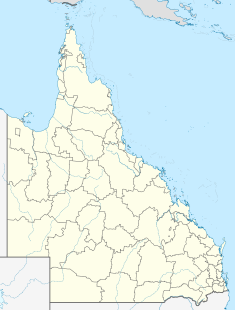Moorlands
| Moorlands | |
|---|---|

Moorlands, 2012
|
|
| Location | 451 Coronation Drive, Auchenflower, Queensland, Australia |
| Coordinates | 27°28′44″S 152°59′55″E / 27.479°S 152.9986°ECoordinates: 27°28′44″S 152°59′55″E / 27.479°S 152.9986°E |
| Design period | 1870s - 1890s (late 19th century) |
| Built | c. 1892 |
| Architect | Richard Gailey |
| Official name: Moorlands | |
| Type | state heritage (landscape, built) |
| Designated | 21 August 1992 |
| Reference no. | 600052 |
| Significant period | 1890s (fabric) 1890s-1960s (historical) |
| Significant components | residential accommodation - main house, gate - entrance, stained glass window/s, views to, cellar, service wing, tower - observation/lookout, views from, trees/plantings |
| Builders | Arthur Smith |
Moorlands is a heritage-listed villa at 451 Coronation Drive, Auchenflower, Queensland, Australia. It was designed by Richard Gailey and was built c. 1892 by contractor Arthur Smith. It was added to the Queensland Heritage Register on 21 August 1992.
Moorlands was constructed in 1892 for the Mayne family of Brisbane. It replaced an earlier timber residence on the site which was known as Moorlands Villa.
Mary Mayne, widow of Patrick Mayne, had purchased the earlier house and almost six hectares in 1878. Patrick Mayne was a prominent Brisbane resident in the 1860s-1870s who owned a butcher shop in Queen Street, served as an alderman of the Brisbane Municipal Council and speculated in property. Mary Mayne and her five children resided in Moorlands Villa until her death in September 1889.
Four of the children, James, William, Isaac and Mary Emelia, continued to occupy the property and decided to build a new house. The foundation stone was laid by Mary Emelia Mayne on 3 June 1892. Beneath this was placed a time capsule, enclosing newspapers of the day and a statement explaining why the house was being built.
The building was designed by architect Richard Gailey, and erected by contractor Arthur Smith. The ground floor contained porch, vestibule, staircase hall, drawing room, parlour, dining room, smoking room, cloakroom, serving room, pantries and kitchen. The basement housed cellars, dairy, stores and laundry. A vestibule, ten bedrooms and several bathrooms were located on the first floor.
...
Wikipedia


